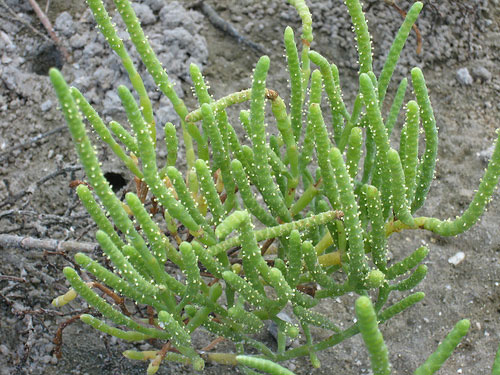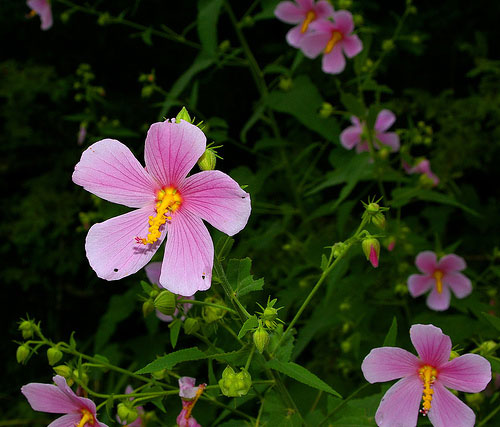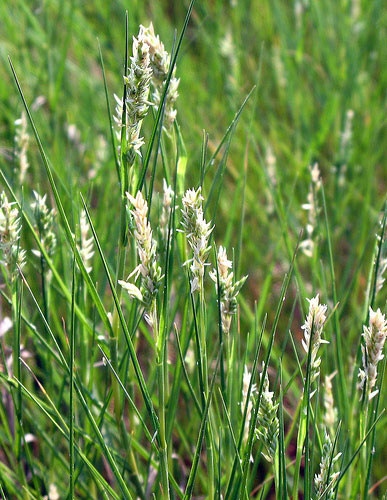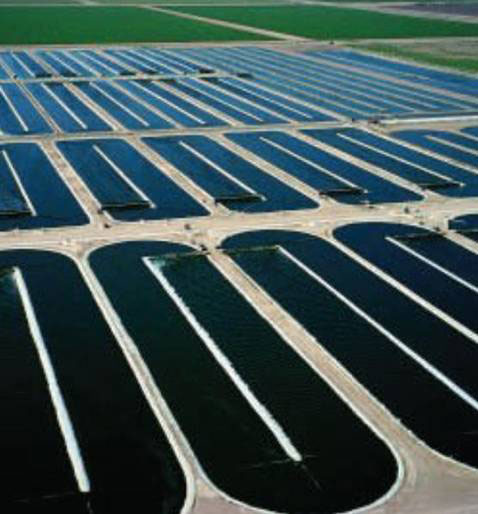Shortage of fresh water poses a much bigger threat to world food supply than the shortage of fossil fuels; cultivating salt-tolerant crops could solve both problems Dr. Mae-Wan Ho and Prof. Joe Cummins
People now use about half of the global supply of fresh water, and good fresh water is becoming an expensive resource. About 1 percent of water on earth is fresh while another 1 percent is brackish (water that has more salt than fresh water, but not as much as seawater), while 98 percent is sea water. Agriculture not only has to compete for limited fresh water resources with home and industrial use; it is being threatened by the spread of soil salinization.
Irrigation of food and feed crops contributes to salinization. High rates of evaporation and transpiration lead to salt accumulation in the root zones as salts are drawn from the deep layers of the soil. Global warming also accelerates salinization as sea level rises and floods coastal regions. Soil salinization is irreversible in arid regions because water is not available to leach the accumulated salts out of the soil. As salinity increases, crop yields decline, because most existing crop plants are not salt-tolerant.
To cope with the shortage of fresh water and increasing salinization of agricultural land, there has been renewed interest in saline agriculture: cultivating crops that are salt-tolerant, so they can grow in brackish water and sea water [1].
Two prominent advocates of saline agriculture are NASA scientists Robert Hendricks (Glenn Research Center, Cleveland, Ohio) and Dennis Bushnell (Langley Research Center, Hampton, Virginia). They want to see halophytes (salt-tolerant plants) being used for food, feed, and fuel [2].
They point out that halophytes could be grown in coastal areas, marshes, inland lakes, desert regions with subterranean brackish aquifers, and directly in oceans or seas. Cultivating halophytes would not compete for land that should be cultivating food [3] (see Biofuels: Biodevastation, Hunger & False Carbon Credits, SiS 33); it would provide more food and feed; and as added bonus, halophytes provide shoreline erosion protection and feeding areas for birds, fish and animals.
Some halophytes may even reclaim the land for freshwater plants. They can leach soil salt through enhanced percolation and, to some extent, through storing salt in their leaves that are harvested and removed from the fields.
By selecting and growing both micro and macro halophytes, we could get proteins, oils, and biomass to provide food, food, and fuel needs.
The oceans are also vast reservoirs of nutrients (nearly 80 percent of required plant nutrients) that could be recycled back to the land for greater sustainability in the grand circular eco-economy of nature (see The Rainbow and the Worm, The Physics of Organisms [4] for more).
Visions of large-scale industry based on halophytes go back to the 1990s [5, 6], when it was already seen to provide sustainable fuel-food supply while increasing the sequestration of carbon dioxide from the atmosphere.
Bushnell [7] points out that there are some 10 000 halophytic plant species, of which 250 are potential staple crops. Vast land areas worldwide are salt affected and major regions overlay saline aquifers. A number of halophytes are now under development [2].The glasswort (Salicornia bigelovli) is a leafless annual salt-marsh plant with green jointed and succulent stems indigenous to the Arabian Sea coasts of Pakistan and India on the margin of salt lakes and Sri Lanka [8]. It produces seeds that are 30 percent oil and 35 percent protein; the oil is similar in fatty acid composition to safflower oil, and hence suitable for edible oil production. Its yield is also superior to soybeans and other oil seeds [2]. The seawater foundation has several hundred hectares under development (www.seawaterfoundation.org).

S. bigelovii, farm2.static.flickr.com
The seashore mallow (Kosteletzkya virginica), a perennial, is one of the many salt-tolerant plants that grow wild on the coastal marshlands or inland brackish lakes, and serves as a source of both feed and fuel [9]. The oil content of the seed is 18 percent, similar to soybean with a fatty acid composition more like cotton seed; but unlike them both, it is a perennial, saving a lot of labour in resowing and sequestering more carbon in the deep roots (See [10] Ending 10 000 Years of Conflict between Agriculture and Nature, SiS 39, for the advantages of perennial crops which are being bred in the Land Institute, Kansas, in the USA to replace the annuals we now grow.)

K. virginica, farm2.static.flickr.com
Distichlis spicata, another perennial, is one of the halophyte grasses used in response to saline-affected lands, and is most suited to the high temperatures and high-radiation regimes in the summer months of southern Australia. In an extensive soil sampling survey conducted sites in Western Australia where D. spicata had been growing for 8 years, a marked improvement in the soil was found compared to control soil, where no grass had been growing. There was a 12-fold increase in water percolation plus increases in carbon and nitrogen content [11]. Australia had an estimated 5.7 million hectares of saline-affected land in 2000, and projected to reach 17 million hectares by 2050. A test carried out there in 2002 [12] confirmed that several NyPa Distichlis cultivars grow well in sea water, with green matter yields up to 25 tonnes/ha and tolerating 1.5 times ocean salt conditions.

D. spicata, farm2.static.flickr.com
John Gallagher who heads the Halophyte Biotechnology Center at the University of Delaware has been developing halophytes cultivated in seawater for a long time [13], producing hay, protein rich grain, and a spinach-like vegetable.
There is a great deal of activity directed at producing biofuels from algae, the potential of which we reported earlier [14] (see Green Algae for Carbon Capture & Biodiesel, SiS 30). The hope is to find halophytic algae that produce more than 30 percent its biomass in oil, and cultivation methods that make it commercially feasible [15]. Many companies have invested in research and development efforts to bring the cost of culture down and the production up to the goal of 50g/m2/day of dry biomass set by the US Department of Energy. Currently, an Israeli company Seambiotic maintains a 1 000 m2 site that can produce approximately 23g/m2/day, according to its scientific advisor and algal growth expert Ami Ben-Amotz. This translates to more than 5 600 gallons/ha/year of algal oil, compared to palm oil yield at 1 187 gal/ha/y, Brazil ethanol at 1 604 gal/ha/y, and soy oil at 150 gal/ha/y.
Hendricks and Bushnell [9] estimate that the theoretical biomass conversion efficiency is 22 percent of the photosynthetic active radiation (400 to 700 nm), or 10 percent of total solar radiation, and is equivalent to 100 g dry biomass per day. In the case of algal oil, it would produce 24 500 gal/ha/y. As some 43 to 44 percent of the Earth landmass is arid or semi-arid, there is considerable potential for developing a multiplicity of seawater irrigated halophyte cultivation and algal aquaculture. An area the size of the Sahara desert (13.6 percent of the world’s arid and semi-arid area) would be sufficient to produce 16 times the energy used by the world in a year (2004). On the current status of the art, algal aquaculture would produce 27.6 percent of the energy used in 2004.

Algae ponds, electricitybook.com
There is already research indicating that various livestock can thrive on halophytes or a combination of halophytes and conventional feed.
Sheep fed with halophyte forage was compared with sheep fed Bermuda grass forage or Bermuda grass mixed with salt to simulate the salt content of the halophyte. Halophyte-fed lambs gained weight at the same rate as control while the salt amended control gained significantly less. The halophyte diet appears to have contained balanced nutrients, which render their high salt level less detrimental than adding the same salt levels to Bermuda grass hay [16]. Cattle fed a halophytic grass gained weight equally to maize fodder fed controls [17]. An extensive review listed numerous halophytes including grasses and legumes that provide suitable forage for animals. The review indicated that grazing halophyte alone can result in salt overload for some animals so they stop feeding and begin to lose weight. A mixed ration of halophyte with conventional hay or maize is therefore advisable. The most salt tolerant farm animal is the camel, followed by sheep, then cattle, followed by horses, and the least tolerant are pigs and chickens [18]. Camels appear to be a promising source of meat in areas where halophytes irrigated with sea water can pasture large camel herds. Camels tolerate drinking water containing up to 2 percent sodium chloride while sea water contains in the range of 3.5 percent sodium chloride. Camels thrive while consuming brackish water and halophytes [19].
In view of so many existing naturally salt-tolerant plants, researchers Jelte Rosema at the Free University, Amsterdam in the Netherlands, and Tim Flowers at the University of Sussex Brighton, in the UK think that the best way ahead is to domesticate wild plants and cross-breed them to produce higher yields [1, 20}. Plants such as sea kale and the asparagus-like samphire, which grow along the coast all over the world have been eaten for thousands of years. Sea kale is now farmed in the Netherlands. Spinach and beetroot are closely related to samphire, and crops such as sugar beet can grow well in salty conditions. .
Genetic modification experiments have been conducted for more than 30 years to try to make crops such as wheat or rice salt tolerant. But Rozema and Flowers say that the genetic manipulations necessary to achieve that for commercial growing may be too complex at present..
Rana Munns’s research team at the Australian CSIRO (Commonwealth Scientific and Industrial Research Organisation) in Canberra had succeeded in breeding a new variety of salt-tolerant durum (pasta) wheat by crossing with an ancient Persian variety [21]. Modern durum wheat is not salt tolerant, but wheat originated from around the Mediterranean which is a heavily salt-affected area. So the researchers went back to the original wheat varieties to find some that were salt tolerant and crossed them into the current wheat. They knew that bread wheat tolerates salty soil, because its roots are good at excluding the salt and letting in the other nutrients, so they looked for salt in the leaves and selected for those that had hardly any salt in them. They found an ancient variety from what is today Iran, which they crossed with the modern durum wheat to get a new salt-tolerant variety. The ability to exclude sodium was associated with two genes Nax1 and Nax2 [22].
Substantial effort has been dedicated to identifying genes and genetic networks involved in salt tolerance, so that crop plants could be enhanced in salt tolerance by conventional selection and breeding. Another approach is to introduce transgenes into the crop plants to enhance salt tolerance, or influence expression of the salt tolerance genes. The naturally highly tolerant crops include beetroot, barley and rye. Moderately tolerant crops include spinach, rice, tomato, olive, wheat, cabbage and oats [23].
Identifying the genes for salt tolerance in halophytes facilitates the improvement of those crops but also provides a source of genes for improving the salt tolerance of conventional crops. Transcript profiling of salt tolerant red fescue grass (Festuca rubra ssp. Litoralis) revealed a complex regulatory network controlling salt stress response. The salt regulated transcripts included those involved in regulating gene transcription and signal transduction found in the cells of the root epidermis, cortex, endodermis and the vascular tissues; while other tissue cells had less active salt transcript activity. The gene transcription results showed coordinated control of ion homeostasis and water status at high salinity [24]. Heat stress was found to alter the expression of salt stress induced genes in the halophyte smooth cord grass [25].
Small proteins that regulate salt stress response in Arabidopsis were identified. Over- expressing one of those genes results in salt tolerance in the plant. Salt directly affects the small protein’s signalling by inducing its degradation [26]. Proteomic analysis on grapevine revealed that 48 out of 800 proteins were altered after exposure to high salt, including 32 that were up regulated, 9 down regulated, and 2 newly expressed. The salt stress response suggests that salt spreads systematically throughout the plant [27]. A gene transcription map was used to identify a set of genes related to salt tolerance in salt-sensitive indica rice seedling compared with a natural salt-tolerant relative. Over one thousand salt regulated genes were identified and several mapped to a QTL (quantitative locus) for salt-tolerance on chromosome 1. Selected members of the genes are considered candidate transgenes for crop improvement [28].
Small regulatory RNA response to salt stress was studied in maize roots. Micro array analysis identified 98 regulatory RNAs that were altered in activity following exposure to salt, along with 18 regulatory RNA molecules that were only active in salt tolerant maize [29].
The results of these studies do confirm the complexity of salt tolerance, which is why transgenesis has so far failed in produce salt tolerant crop plants beyond the greenhouse stage. On the other hand, these results will help considerably in enhancing the salt tolerance of crops by marker assisted conventional selective breeding.
There have been a number of attempts to creat salt tolerant crops by introducing and over-expressing certain ‘major’ genes involved in salt tolerance.
Transgenic salt tolerant tomato plants were created by over-expressing a gene taken from Arabidopsis, encoding the vacuolar Na+/H+ antiporter protein. The transgenic tomato accumulated salt in the leaves but not in fruit. The transgenic protein transports sodium ions from the cytoplasm into membrane-bound vacuoles within the plant cell, thereby isolating them from the cell cytoplasm. Tomatoes that are normally somewhat resistant to salt become sufficiently resistant to survive exposure to 1.2 percent sodium chloride that kills the non-transgenic controls [30].
Transgenic salt tolerant sugar beet expressing the same Arabidopsis vacuolar sodium/hydrogen antiporter gene used in the salt tolerant tomato accumulated more soluble sugar but less salt in the storage roots than did unmodified beets [31]. The same gene over-expressed in trangenic tall fescue (a perennial grass) enabled the grass to survive 1.2 percent sodium chloride [32]; while transgenic maize with the antiporter gene survived 0.8-1.0 percent salt solutions [33].
Mn superoxide dismutase (SOD) is a critical enzyme eliminating reactive oxygen species in plants under environmental stresses. Transgenic Arabidopsis over-expressing it (more than 2 fold) tolerated 150 mM (~0.9 percent NaCl). Other antioxidative enzymes such as Cu/Zn-SOD Fe-SOD, catalase and peroxidase in transgenic plants treated with NaCl were also markedly higher than those of wild type plants, and contents of malondialdehyde were lower than those of wild type plants, which shows that Mn SOD plays a key role in protecting the plant against reactive oxygen species in stressful conditions [34].
Over-expression of an NAC transcription factor from rice enhanced both drought resistance and salt tolerance [35]. The NAC transcription family is large and diverse; it includes those regulating embryonic, floral and vegetative development, lateral root formation and auxin signalling, defence, and abiotic stress.
Salt tolerance is clearly a very complex character, linked to stress and other developmental responses. Not only is it difficult to genetic engineer successfully in crop plants. Apart from the usual hazards inherent to genetic modification [36] (GM is Dangerous and Futile, SiS 40), the very complexity of salt tolerance increases the possibilities for unexpected, unintended effects.
On the other hand, as we have shown, there is much scope for domesticating a range of existing halophytes that already perform well in salt-affected environments, and for improving salt tolerant crops by conventional marker-assisted breeding. That is by far the best way forward
Article first published 24/02/09
Comments are now closed for this article